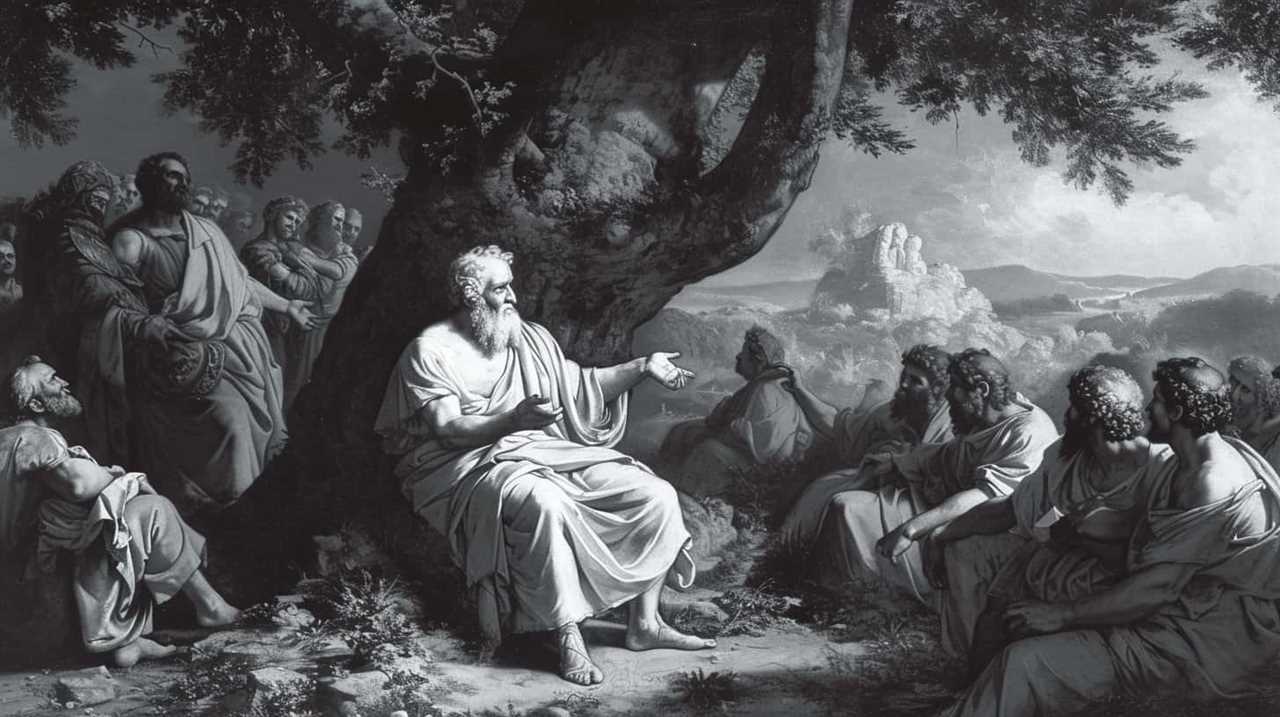Have you ever thought about the mysteries behind the influence of art? Well, guess what? We have discovered six amazing philosophical observations from the one and only Aristotle!
In our journey to explore the depths of art, Aristotle reveals to us the profound wisdom that lies within. From the concept of imitation as the foundation of art, to the role of emotions in evoking a response, to the importance of balance and beauty, Aristotle’s teachings offer us a new perspective on the transformative power of art.
Through art, we can experience catharsis, connect with nature, and ultimately serve others. So join us as we delve into the mind of Aristotle and unlock the mysteries of art that have captivated humanity for centuries.
Let the journey begin!
Key Takeaways
- Aristotle emphasizes the role of imitation in art
- True artistic expression requires observation and imitation of the natural world
- Emotions play a crucial role in the creation and reception of art
- Art provides a transformative experience for individuals, offering catharsis and healing

Imitation as a Basis for Art
One of Aristotle’s key insights about art is that it’s fundamentally based on imitation. In his philosophical work, Aristotle emphasizes the role of creativity in artistic expression, while also recognizing the importance of imitating the natural world. According to Aristotle, artists use their creative abilities to imitate and represent the world around them, translating their observations and experiences into their artistic creations.
The role of creativity in art can’t be understated. Artists possess a unique ability to envision and bring forth new ideas, combining elements from their imagination with the reality they perceive. This creative process allows artists to express their unique perspectives and emotions through their artwork, creating a connection between the artist and the audience. Through their creative choices, artists have the power to evoke emotions, challenge societal norms, and inspire change.
However, Aristotle argues that true artistic expression also requires imitation. By observing and imitating the natural world, artists can create works that resonate with the audience on a deeper level. Through imitation, artists capture the essence of reality, presenting it in a way that’s both familiar and thought-provoking. This imitation allows the audience to relate to the artwork and find meaning in it, establishing a connection between the artist, the artwork, and the viewer.

The Role of Emotions in Art
The connection between art and emotions can be explored through the role that emotions play in the creation and reception of artistic works. Emotional expression is a fundamental aspect of art, as artists often draw upon their own emotions to create meaningful and impactful pieces. Through their work, artists aim to evoke specific emotions in the audience, whether it be joy, sadness, anger, or awe. Emotions serve as a driving force behind artistic interpretation, influencing the choices artists make in terms of subject matter, composition, color palette, and technique.
Artistic interpretation allows artists to convey their own emotions and experiences to the audience, creating a sense of connection and empathy. By expressing their emotions through their work, artists offer a glimpse into their inner world, inviting the audience to share in their feelings and experiences. This emotional connection can be deeply moving and transformative, as it allows individuals to explore and process their own emotions through the lens of the artwork.
On the other hand, emotions also play a crucial role in the reception of art. When experiencing a piece of art, individuals bring their own emotions and experiences to the interpretation. This subjective emotional response adds depth and richness to the artwork, as each individual may resonate with different aspects of the piece based on their own emotional state.
In conclusion, emotions are integral to the creation and reception of art. Emotional expression and interpretation allow artists to convey their inner experiences, while also inviting the audience to engage with their own emotions. This emotional connection forms the basis of the profound impact that art can have on individuals.
Transitioning to the next section, we’ll now explore the concept of beauty and its relation to art.

Beauty and Its Relation to Art
As we delve into the realm of beauty and its connection to art, we can further explore the profound impact that aesthetics have on both the creation and reception of artistic works. Beauty, in the context of art, is often seen as subjective, varying from person to person based on individual preferences and experiences. It’s a complex concept that’s deeply intertwined with artistic expression.
Artistic expression is the means by which artists convey their thoughts, emotions, and ideas to the world. It’s through this expression that beauty manifests itself in various forms. Artists use different techniques, materials, and styles to create works that they believe capture and communicate beauty. Whether it’s a painting, a sculpture, a piece of music, or a dance performance, each form of artistic expression aims to evoke a sense of beauty in its audience.
However, the concept of beauty in art isn’t limited to the physical appearance of the artwork. It goes beyond mere aesthetics and encompasses the ability of the artwork to evoke emotions, stimulate intellectual curiosity, and provoke introspection. A beautiful artwork has the power to move us, to make us question our beliefs, and to inspire us to see the world from a different perspective.
While beauty may be subjective, the impact it has on the creation and reception of art is undeniable. Artists strive to create works that are aesthetically pleasing and emotionally resonant, aiming to evoke a sense of beauty in the viewer. On the other hand, the audience’s perception of beauty plays a crucial role in how they engage with and interpret the artwork. The subjective nature of beauty allows for diverse interpretations and responses, enriching the overall artistic experience.

Art as a Means of Catharsis
Art provides a transformative experience for individuals, allowing us to engage with our emotions and achieve catharsis. The concept of catharsis, as understood by Aristotle, refers to the release of pent-up emotions through artistic expression. Art has the power to tap into our deepest emotions, offering a cathartic release that can be both healing and transformative.
Through art, we’re able to express and explore our emotions in a safe and controlled environment. Whether it’s through painting, music, dance, or any other form of artistic expression, we can channel our innermost thoughts and feelings into a tangible creation. This process allows us to confront and process our emotions, leading to a sense of relief and emotional release.
The healing power of artistic expression lies in its ability to provide a space for self-reflection and introspection. By engaging with art, we’re able to gain insight into our own experiences and emotions, as well as those of others. This empathetic connection can foster a sense of understanding and compassion, not only towards ourselves but also towards others who may be going through similar struggles.
Furthermore, art can serve as a means of communication, enabling us to share our experiences and connect with others on a deeper level. When we create or consume art that resonates with us, we feel a sense of validation and connection, knowing that we aren’t alone in our experiences. This sense of connection can be incredibly powerful, providing solace and support during difficult times.

The Importance of Balance in Art
Engaging with art frequently allows us to appreciate the importance of balance in creative expression. When we observe different forms of art, we begin to recognize that balance is a crucial element in creating aesthetically pleasing and impactful works. Here are three key insights into the significance of balance in art:
- Symmetry in art: Symmetry refers to the visual balance achieved through mirroring or equal distribution of elements within a composition. This balance can be found in various art forms, such as architecture, painting, and sculpture. Symmetrical compositions often create a sense of stability and order, appealing to our innate desire for harmony.
- Harmony in artistic compositions: Harmony is the delicate balance between different elements in a work of art. It involves the careful arrangement of colors, shapes, textures, and proportions to create a sense of unity and coherence. When these elements are harmoniously combined, they evoke a pleasing and balanced aesthetic experience for the viewer.
- Balancing contrasting elements: Balance in art doesn’t necessarily mean perfect symmetry or complete uniformity. It can also be achieved by skillfully juxtaposing contrasting elements. Artists often play with opposing forces, such as light and dark, chaos and order, or soft and hard textures, to create dynamic and engaging compositions. This intentional imbalance can evoke a sense of tension, intrigue, and emotional depth in the artwork.

Art as a Reflection of Nature
In our exploration of ‘Art as a Reflection of Nature’, we discover the profound connection between artistic expression and the natural world. Artistic interpretation allows us to capture and convey the beauty, complexity, and diversity of the natural world through various mediums. Artists have long been inspired by the landscapes, flora, and fauna that surround them, using their creative abilities to depict nature’s wonders.
Artistic expression serves as a means of not only representing the physical aspects of nature but also capturing its essence and evoking emotional responses from the viewer. Through art, we can experience the tranquility of a serene landscape, the power of a raging storm, or the delicacy of a blooming flower. Artists use their unique perspectives and skills to translate these natural phenomena into visual, auditory, or tactile forms, allowing us to appreciate and connect with nature on a deeper level.
Furthermore, art can also serve as a mirror, reflecting our relationship with the natural world. It can raise awareness about environmental issues, provoke thought, and encourage action. Artists throughout history have used their work to address topics such as deforestation, pollution, and the impact of human activities on the environment. By highlighting these issues, art can inspire change and promote a more sustainable future.

Frequently Asked Questions
How Can Aristotle’s Concept of Imitation Be Applied to Contemporary Art Forms Such as Abstract or Conceptual Art?
Imitation in contemporary art, influenced by Aristotle, can be found in abstract and conceptual art. While these forms may not directly mimic reality, they imitate ideas and concepts, challenging viewers to engage with art in a new and thought-provoking way.
What Are Some Examples of Artworks That Successfully Evoke Specific Emotions According to Aristotle’s Theory of Art?
Examples of artworks that successfully evoke specific emotions, according to Aristotle’s theory of art, include Michelangelo’s "The Pieta" which elicits a sense of compassion and Da Vinci’s "Mona Lisa" which evokes curiosity and intrigue.
Can Beauty in Art Be Objectively Defined, or Is It Purely Subjective?
Beauty in art is a complex concept that involves both objective and subjective elements. While there may be certain universal standards of beauty, personal interpretation plays a significant role in determining what is considered beautiful.
Are There Any Limitations or Criticisms of Aristotle’s Theory of Catharsis Through Art?
There are limitations and criticisms of Aristotle’s theory of catharsis through art. Some argue that it is subjective and lacks empirical evidence, while others question its ability to truly purge emotions.
How Does Aristotle’s Idea of Balance in Art Relate to the Concept of Artistic Freedom and Experimentation in Modern Art?
Artistic freedom in modern art often pushes boundaries and encourages experimentation. However, Aristotle’s idea of balance in art reminds us of the importance of harmony and proportion, providing a foundation for innovative yet balanced artistic expression.

Conclusion
In conclusion, Aristotle’s philosophical insights on art provide a profound understanding of its nature and purpose.
Like a skilled painter using a delicate brush, Aristotle unveils the intricacies of art, showing how it imitates life, evokes emotions, and captures the essence of beauty.
Through art, we find catharsis, balance, and a reflection of the natural world.
Aristotle’s timeless wisdom continues to guide our appreciation and interpretation of art, like a compass that leads us through the vast ocean of human creativity.
Lauren’s talent in writing is matched by her passion for storytelling. Her love for books and deep understanding of culture and entertainment add a distinct flavor to her work. As our media and press contact, Lauren skillfully bridges the gap between afterQuotes and the broader media landscape, bringing our message to a wider audience.










